
Chance Theater challenges adventurous theatergoers and rewards them in equal measure with director Trevor Biship’s powerfully staged vision of Sarah Ruhl’s Passion Play, three acts, two intermissions and all. Bows may not get taken till nearly three-and-a-half hours after curtain, but if you’re anything like this reviewer, you’ll find yourself enthralled from fanciful start to emotional finish.
Passion Play has the two-time Pulitzer Prize finalist examining how a centuries-old theatrical tradition (the titular depiction of The Passion Of The Christ) and the folks who take part in the spectacle year after year are affected by the epoch in which they create this annual event.
Told in hands less deft that Ruhl’s, such heavy subject matter might prove too weighty to be entertaining. Fortunately, the playwright who gave us The Clean House, Eurydice, and—most famously—In the Next Room (or The Vibrator Play), ensures that her 2003/2004 drama has more than its fair share of whimsy, quirkiness, and lyrical charm.
Ruhl’s three-act Passion Play (really three distinct albeit related hour-long one-acts) unfolds first in Elizabethan England, then in 1934 Nazi Germany, and finally in mid-to-late 20th Century South Dakota, a major political leader from each era taking advantage of this dramatic reenactment of Christ’s trial, suffering and death to suit his or her own purposes.
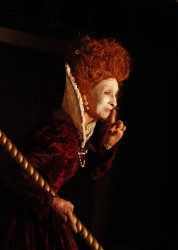 To Queen Elizabeth, the Passion Play must be shut down as part of her efforts to banish Roman Catholicism from the land. To Adolph Hitler, the Passion Play’s most controversial aspect, its damnation of the Jews as Christ Killers, serves his political agenda to malevolent perfection. To President Ronald Reagan, a Midwestern staging of the Passion Play symbolizes his administration’s emphasis on good old-fashioned “family values.”
To Queen Elizabeth, the Passion Play must be shut down as part of her efforts to banish Roman Catholicism from the land. To Adolph Hitler, the Passion Play’s most controversial aspect, its damnation of the Jews as Christ Killers, serves his political agenda to malevolent perfection. To President Ronald Reagan, a Midwestern staging of the Passion Play symbolizes his administration’s emphasis on good old-fashioned “family values.”
That playwright Ruhl has a single actor (Karen Webster at the Chance) bring to gender-bending life all three of these historical figures is but one aspect of Passion Play’s unique fascination.
All three eras feature the same cast of actors, some of them playing three separate incarnations of the same character while others play a trio of very different characters serving similar dramatic functions.
Ben Moroski’s John, Eric, and J are all the Passion Play’s Jesus, the first a sweet, rather asexual fisherman; the second more sexually ambiguous, at one point sharing a passionate same-sex kiss; the third a decidedly hetero soap opera heartthrob. Likewise, all three characters brought to life by Casey Long portray the Passion Play’s Pontius Pilate, the third of them the evening’s most dramatic and powerfully rendered, a Vietnam vet unable to shake the post traumatic stress disorder brought upon by the horrors of war.
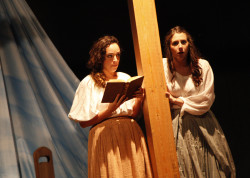 Camryn Zelinger’s Mary I (the Virgin) and Katelyn Schiller’s Mary 2 (the Magdalene) are likewise given strikingly different variations on the same character in each act. Zelinger’s lusty Elizabethan wench bears only superficial resemblance to the glamorous German actress of Act Two and Act Three’s Midwestern wife torn between two brothers. Schiller gets to play Mary Magdalene’s interpreter first as a young woman confused by her same-sex longings, then as the daughter of the elderly man whose traditional role as Christ has been taken over by his son, and finally as a folksy, salt-of-the earth toll booth worker in Act Three.
Camryn Zelinger’s Mary I (the Virgin) and Katelyn Schiller’s Mary 2 (the Magdalene) are likewise given strikingly different variations on the same character in each act. Zelinger’s lusty Elizabethan wench bears only superficial resemblance to the glamorous German actress of Act Two and Act Three’s Midwestern wife torn between two brothers. Schiller gets to play Mary Magdalene’s interpreter first as a young woman confused by her same-sex longings, then as the daughter of the elderly man whose traditional role as Christ has been taken over by his son, and finally as a folksy, salt-of-the earth toll booth worker in Act Three.
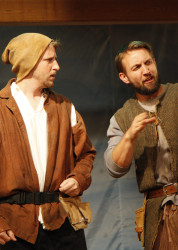 Also figuring prominently in the action are Andrew Eiden And Lee Kociela as a pair of carpenters charged with nailing Christ to the cross and Robert Foran as the director of all three eras’ Passion Play.
Also figuring prominently in the action are Andrew Eiden And Lee Kociela as a pair of carpenters charged with nailing Christ to the cross and Robert Foran as the director of all three eras’ Passion Play.
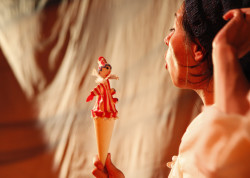 Alex Bueno is given the plum assignment of Act One and Two’s Village Idiot, rendered a particular outsider in Nazi Germany, and in Act Three as the child-turned-adolescent who may be the daughter of one man or perhaps his brother’s offspring. Karen O’Hanlon brings to life a trio of outsiders—a visiting Friar, a visiting Englishman, and a VA psychiatrist, doing some gender-bending of her own in the first two roles, while Jackson Tobiska gets to play a machinist, a rather frightening German Officer, and an almost equally frightening young stage director.
Alex Bueno is given the plum assignment of Act One and Two’s Village Idiot, rendered a particular outsider in Nazi Germany, and in Act Three as the child-turned-adolescent who may be the daughter of one man or perhaps his brother’s offspring. Karen O’Hanlon brings to life a trio of outsiders—a visiting Friar, a visiting Englishman, and a VA psychiatrist, doing some gender-bending of her own in the first two roles, while Jackson Tobiska gets to play a machinist, a rather frightening German Officer, and an almost equally frightening young stage director.
Ruhl’s Passion Play is an epic undertaking for any theater. (Ruhl suggests the possibility of staging Acts One/Two and Act Three in rep, or for two theater companies to divide the play between them.) Then again, “chance” is part of the Anaheim Hills theater’s name, so taking adventurous chances is nothing new for Orange County’s finest intimate theater (turned “midsized-intimate” since the recent opening of its Bette Aitken Theater Arts Center).
Scenic designer Fred Kinney’s set (a raised wooden stage which morphs into three distinct configurations to differentiate between the play’s three eras) surrounds the theater’s four walls with wood panels, and since director Biship has his actors not only onstage but in the aisles and even behind the audience (seated on three sides), theatergoers are given the feeling of being right there where the Passion Plays get performed.
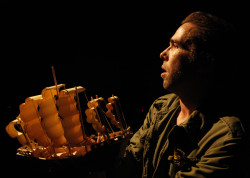 Add to Kinney’s scenic design Brandon Baruch’s dazzling lighting (the blood red that bathes the stage at various moments throughout is startlingly effective), Jeff Polunas’s dramatic, atmospheric sound design, Sara Ryung Clement’s stunning three-era costumes, and Christopher Scott Murillo’s breathtaking puppets (the fish effects are exquisite blends of sheer fabric and light) and props (including intricately detailed model sailing ships) and you’ve got a unifying production design as fine as any you’ll see inside the OC or out.
Add to Kinney’s scenic design Brandon Baruch’s dazzling lighting (the blood red that bathes the stage at various moments throughout is startlingly effective), Jeff Polunas’s dramatic, atmospheric sound design, Sara Ryung Clement’s stunning three-era costumes, and Christopher Scott Murillo’s breathtaking puppets (the fish effects are exquisite blends of sheer fabric and light) and props (including intricately detailed model sailing ships) and you’ve got a unifying production design as fine as any you’ll see inside the OC or out.
Under Biship’s inspired direction, a cast of eleven combining Chance Theater resident artists, regulars, and first-timers simply could not be better.
Long’s three Pontiuses (in particular his raging, shell-shocked war vet) may represent the Chance resident artist’s most unforgettable work to date, with fellow resident artist (and Chance Theater treasure) Webster treating audiences to three precisely etched historical icons, each with a flair for the theatrical, while resident artist number three Tobiska once again excels as a trio of especially strong-willed characters.
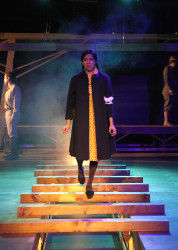 As for longtime resident artist Bueno, she too may never have been quite as memorable as she is as a) the proverbial village idiot, b) a child who puts a human face on a demonized race, and c) an All-American girl in search of her identity in late 20th-Century USA. (Bueno also takes centerstage in one of the most gut-punchingly devastating pre-intermission blackouts you’re likely ever to see.)
As for longtime resident artist Bueno, she too may never have been quite as memorable as she is as a) the proverbial village idiot, b) a child who puts a human face on a demonized race, and c) an All-American girl in search of her identity in late 20th-Century USA. (Bueno also takes centerstage in one of the most gut-punchingly devastating pre-intermission blackouts you’re likely ever to see.)
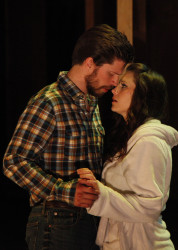 Making return appearances to the Chance are the gorgeous Zelinger (proving herself as fine a dramatic actress as she was a musical theater dazzler in last February’s Lysistrata Jones), O’Hanlon (crossing genders to delightful effect), and Foran (excellent too as three quite distinct Passion Play directors).
Making return appearances to the Chance are the gorgeous Zelinger (proving herself as fine a dramatic actress as she was a musical theater dazzler in last February’s Lysistrata Jones), O’Hanlon (crossing genders to delightful effect), and Foran (excellent too as three quite distinct Passion Play directors).
And then there are the Chance Theater newbies, most impressively the sensational Schiller as three very different, equally heartbreaking Marys, and the striking Moroski, whose John, Eric, and J couldn’t be more distinctly drawn or powerfully rendered. Eiden and Kociela are pretty darn terrific too as three pairs of carpenter twins, and like Zelinger and Schiller, the family resemblance between stage siblings is both remarkable and serendipitous.
Carla Neuss is dramaturg. Bebe Herrera is stage manager and Marissa Drammissi assistant stage manager. Additional behind-the-scenes credit goes to Brittany Blouch (assistant puppets/prop design), Claire Livingston (assistant costume design) and Danielle Goodin (assistant to the director).
Chance Theater is headed by artistic director Oanh Nguyen. Long is managing director, Erika C. Miller development director, Masako Tobaru production manager/technical director, Teodora Ramos master carpenter, Jeff Hellebrand box office associate, Jocelyn A. Brown associate artistic director, Jennifer Ruckman literary manager, and Marc Sanford associate house manager.
It takes passion aplenty to produce a play as epic as Passion Play, and despite its considerable length and abundant challenges, it’s hard to imagine a more accessible, audience-friendly interpretation of Ruhl’s dense, fanciful, ultimately quite moving three-acter than the one now playing in Anaheim Hills.
Chance and Passion make for a potent combination at the Chance.
Chance Theater, 5522 E. La Palma Ave., Anaheim Hills.
www.chancetheater.com
–Steven Stanley
May 2, 2014
Photos: Thamer Bajjali, Petra Calling Photography
Tags: Chance Theater, Orange County Theater Review, Passion Play, Sarah Ruhl

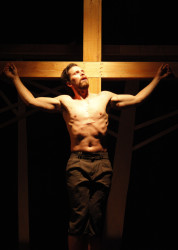
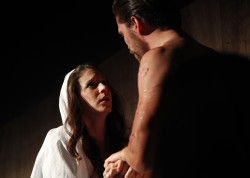

 Since 2007, Steven Stanley's StageSceneLA.com has spotlighted the best in Southern California theater via reviews, interviews, and its annual StageSceneLA Scenies.
Since 2007, Steven Stanley's StageSceneLA.com has spotlighted the best in Southern California theater via reviews, interviews, and its annual StageSceneLA Scenies.







 COPYRIGHT 2024 STEVEN STANLEY :: DESIGN BY
COPYRIGHT 2024 STEVEN STANLEY :: DESIGN BY